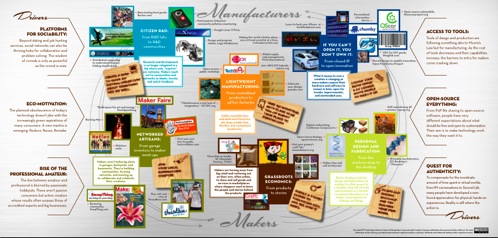
I'm a research director at Institute for the Future, a 40-year-old non-profit thinktank that helps companies, governments, and foundations think about long-term future trends to make better decisions today. For the last six months, we've been researching the "future of making," exploring how the stuff of our world may be researched, invented, designed, manufactured, and distributed in the next ten years. We held an expert workshop where we brought in a terrific group of makers, conducted interviews, and did a ton of reading on the history of DIY culture. At last weekend's Maker Faire, we released the results of our research in the form of a visual knowledge map, summarizing drivers, trends, and implications. Almost all of our research at IFTF becomes free and public after a year, but this map was made public right away and is Creative Commons-licensed. We hope you enjoy it! From the introduction to the Future of Making Map:
THE FUTURE OF MAKING IS BEING REMADELink
Two future forces, one mostly social, one mostly technological, are intersecting to transform how goods, services, and experiences—the “stuff” of our world—will be designed, manufactured, and distributed over the next decade. An emerging do-it-yourself culture of “makers” is boldly voiding warranties to tweak, hack, and customize the products they buy. And what they can’t purchase, they build from scratch. Meanwhile, flexible manufacturing technologies on the horizon will change fabrication from massive and centralized to lightweight and ad hoc. These trends sit atop a platform of grassroots economics—new market structures developing online that embody a shift from stores and sales to communities and connections.
Inspired by the hackers, crafters, artisans, and tinkerers who embody this “maker mindset,” we set out to reverse engineer the future forces behind this transformation. Many of us were already immersed in the DIY culture, hacking code, soldering circuits, creating media, and even tending farms. So to learn more, we reached out to our own communities, brought together innovators at an expert workshop, scoured blogs and magazines, and attended numerous informal gatherings where makers talk shop. It turns out that “do it yourself” may be a misnomer for this decidedly social movement; “do it ourselves” is a more apt phrase. Individual makers are amplified by social technologies that connect ideas, designs, techniques, and, of course, people, to revolutionize the process of innovation and production.
There is much to be learned from the maker mindset of collaboration, creativity, and open access. Yet the maker culture will not replace traditional industry. In the future, traditional manufacturers and maverick makers will be closely linked— sometimes cooperating, sometimes competing, but frequently blurring the boundaries that separate them. Success will occur when the two cultures are woven together in new and interesting ways. We hope that our map will help guide you in those experiments as you engage with the Future of Making.

